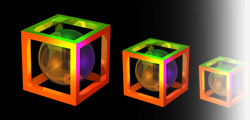Description
- Instructor:
- Bruce Draper
Office: 442 CS Building
Office Hours: Mondays 10:00; Tuesdays 10:00-11:00
Email: draper@cs.colostate.edu - GTA:
- Quanyi Mo
Office: CSB120, Linux Lab
Office Hours: 4:00-5:00, Wed
Email: moquanyi@cs.colostate.edu
- Lecture Time and Place:
- 3:30-4:45, Tue, Thur, CSB Room 130
CS 410 teaches students how to program a computer to generate photo-realistic images. The general idea is that given a scene model, a sensor model and a viewpoint, one should be able to create the same image that a camera would for that scene and viewpoint. Scene models include 3D object models and light sources. Objects models are composed of surfaces, and include both geometry (where is the surface?) and material properties (what is it made of? What color is it?).
This course will emphasize geometric objects and transformations, perspective projections, lighting and reflectance models, shading models, and 3D curves and surfaces. Students will design and implement a ray tracing program from scratch, thereby becoming intimately familiar with the sensor, lighting and object models described above. Perhaps most importantly, students may come to more fully appreciate the power of linear algebra.
Prerequisites
In order to understand the material in this course, you will need to have a good working knowledge of data structures such as linked lists, trees, symbol tables, including dynamically allocated structures. You will need to know how to implement these data structures in C++ or Java. This course will also draw on knowledge of the 2D and 3D geometry of vectors and coordinate systems, and on the use of matrix algebra for coordinate transformations. In other words, you should be familiar with material on the above topics covered in M229 (Matrices and Linear Equations), CS200 (Algorithms and Data Structures), CS253 (Software Development with C++) and CS314 (Software Engineering).
Textbook
The textbook for this course is: Fundamentals of Computer Graphics by Shirley and Marschner. You may buy a physical copy of this book from the University bookstore (or elsewhere), or you may an electronic version directly from the publisher. The ISBN number is 9781439893746.
Grading
Here are the formally graded elements of the course and associated weighting:
| Activity | Weight |
|---|---|
| Term Paper | 10 % |
| Programming Assignments | 45 % |
| Midterms (2) | 25 % |
| Final Exam | 20 % |
Semester grades are determined by the weighted sum of points earned in each of these areas. Total points for each area are normalized so that the best possible score for the semester is 100. Typically the A- to B+ cutoff falls at 90 points, the B- to C+ cutoff at 80 points, and so on. While this is the typical grading procedure, the instructor reserves the right to make adjustments.
Exams and projects will always be done individually and grades assigned on an individual basis. Further, students not already familiar with the CSU Honor Pledge should review this clear and simple pledge and always adhere to it.
Late and Makeup Policy
Midterm and Finals: Make-up exams are only given for unforeseeable emergencies (e.g., medically documented illness). Students must consult with the instructor as soon as possible, preferably before the start of the exam. Course examination dates are listed in the syllabus; be aware of them and plan accordingly.
Projects: Unless otherwise specified, programming assignments are to be submitted electronically through RamCT. Specifics will be included in each assignment. Always check the assignment page for due dates. Electronic submission closes when assignments are due; students not having submitted programs receive an automatic zero on the assignment.
Important Dates
| First in class midterm | Tues., Sept. 29th |
| Second in class midterm | Tues., Nov. 10th |
| Final Exam | Monday, December 14th, 6:20 to 8:20 PM |
Both midterms and the final exam will be held in the same classroom as regular lectures. While no changes to the midterm dates are anticipated, the instructor reserves the right to change these dates with one weeks notice.
In Class Participation
All students taking this course are expected to participate actively. This includes asking and responding to questions. Questions may be asked or answered in class, via email, or during office hours.
Professional Conduct
All students are expected to conduct themselves professionally. We (the instructors and GTAs) assume you are familiar with the policies in the student information sheet for the department. Additionally, you are computing professionals, albeit perhaps just starting. You should be familiar with the code of conduct for the primary professional society, ACM. You can read the ACM Code of Conduct HERE.
We work to maintain an environment supportive of learning in the classroom and laboratory. Towards that end, we require that you be courteous to and respectful of your fellow participants (i.e., classmates, instructors, GTAs and any tutors). In particular:
- Please turn off the ring on your cell phone. If you are expecting an emergency call, sit near the door and slide out discretely to take it.
- In class use of electronic devices in general, and laptops specifically, is permitted as a courtesy so that you may better participate and learn. If at any time the instructor judges that an electronic device is becoming a distraction the student may be asked to to turn it off and put it away.
- All exams and quizzes are to be done without the aid of notes of any kind. Laptops and all other electronic devices must be shut and put away during exams and quizzes.

